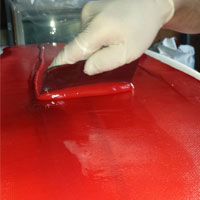
Understanding the Different Types of Surfboard Resin
When building a surfboard, one of the most critical decisions you'll make is choosing the right resin. Resin is what binds the fiberglass cloth to the surfboard, giving it strength, durability, and a glossy finish. There are several types of resins used in the industry, each with its unique properties and benefits. In this guide, we'll explore the two most common types of surfboard resins: polyester and epoxy, with a focus on how they impact the performance and longevity of your surfboard.
Polyester Resin: The Old Standard (Can't really say 'good' old standard though...)
For decades, clear orthophthalic unsaturated polyester resin has been the go-to choice for laminating surfboards. This type of resin, commonly referred to as "Poly" is still widely used in the production of various composite materials, including marine components like boats, as well as wind turbine blades, sailboards, wakesurf boards, skimboards, and even industrial products like sewer pipes and water tanks.
Why is Polyester Resin Popular?
Polyester resin is used in the surfboard industry for several reasons:
- Ease of Use: Polyester resin is user-friendly, meaning it wets out fiberglass quickly and cures reliably. This makes it a practical choice for both professional shapers and those new to surfboard construction. It cures quickly (relative to the amount of catalyst added) which means surfboards can be built faster. Adding only 1 drop of catalyst to polyester resin will make it cure eventually, although it'll take a long time.
- Easy to Sand an Polish: Adding Surfacing Wax to polyester resin in the hotcoat and gloss stages of the board build makes it easy to sand. The hardness (brittleness) of the cured resin is cut very easily with abrasives like sandpaper. Surfboards glassed with polyester resin can be polished to a mirror finish with polishing compound and polish.
- Clarity and UV Resistance: The clarity of polyester resin is another reason it is used for surfboard construction. When cured, it produces a water-clear finish. This aesthetic quality is important for the visual appeal of the surfboard. Additionally, this resin offers good UV resistance, helping to slow the inevitable yellowing or degrading under prolonged exposure to sunlight.
The Evolution of Silmar Brand Polyester Resin
The Silmar brand, a well-known name in the surfboard industry, introduced an improved version of its polyester resin, known as Silmar 2880. While still based on orthophthalic polyester, this new formulation included an acrylic modifier, enhancing its performance in several key areas.
- Improved UV Resistance: Silmar 2880 has undergone extensive UV testing, and the results show that it significantly outperforms other commercially available surfboard resins. This means surfboards laminated with Silmar 2880 are less likely to yellow or degrade over time, even with regular sun exposure.
- Increased Durability: This resin has also been reported to produce tougher surfboards with fewer compression dimples. Compression dimples are small dents that can form on the deck of a surfboard due to repeated pressure from the rider's feet. By reducing the occurrence of these dimples, Silmar 2880 helps maintain the structural integrity and appearance of the board.
- Enhanced Impact Resistance: Another benefit of Silmar 2880 is its improved impact resistance. This makes the surfboard more resistant to stress and less likely to develop cracks, especially on the deck where the rider applies the most pressure.
Drawbacks of Polyester Resin
1. Strong Odor: Polyester resin emits a strong chemical odor during curing, which can be harmful if proper ventilation isn't maintained. An organic respirator must be worn when using it and the smell lingers for days in your workspace.
2. Cancer Causing: Polyester resin is a know carcinogenic and much caution must be used when handling and inhaling the resin.
2. Brittleness: Polyester resin is prone to cracking under stress due to its brittleness. However, Silmar 2880 formula improves durability and toughness.
3. Limited Temperature Resistance: Polyester resin doesn't perform well in high-temperature environments, making it less suitable for surfboards used in hot climates.
4. Prone to Shrinkage: During curing, polyester resin can shrink, leading to distortions in the final product, which requires careful management, especially for beginners.
Epoxy Resin: The Modern Choice
Epoxy resin has been gaining popularity in the surfboard industry, particularly over the last 20 years. Its rise to prominence was partly triggered by the unexpected closure of Clark Foam in 2005, a major supplier of polyurethane foam used in traditional surfboard construction (now US Blanks). This event caused a significant disruption in the industry, forcing shapers to explore alternative materials. Epoxy resin, used in conjunction with expanded polystyrene (EPS) foam, quickly emerged as a viable option. Brian from Greenlight had already been building his personal boards with EPS and Epoxy resin back then and the closure of Clark Foam triggered his desire to share his knowledge of better board building materials and techniques to all surfers.
Advantages of Epoxy Resin
Epoxy resin offers several advantages over traditional polyester resin, making it an appealing choice for modern surfboard builders:
- Stronger and Lighter: Epoxy resin is generally stronger and lighter than polyester resin. This means surfboards made with epoxy are more durable while being easier to carry and maneuver in the water. The increased strength of epoxy resin also makes it more resistant to dings and other forms of damage.
- Better Flexibility: Epoxy resin has a higher elongation at break compared to polyester resin, meaning it can stretch more before breaking. This added flexibility can be beneficial for surfboards, allowing them to better absorb impacts and stresses, which can extend the life of the board.
- Reduced Environmental Impact:** Epoxy resin is often considered a more environmentally friendly option because it typically emits fewer volatile organic compounds (VOCs) during the curing process. Additionally, EPS foam, which is commonly used with epoxy resin, is more recyclable than polyurethane foam.
Challenges of Working with Epoxy Resin
Despite its advantages, working with epoxy resin comes with its own set of challenges:
- Longer Curing Times: When epoxy resin was first introduced to the surfboard industry, one of the main drawbacks was its longer curing time. Glassing a surfboard with epoxy took significantly longer than with polyester resin, which could slow down production. However, advancements in epoxy formulations have since reduced these curing times, making the process more efficient. Greenlight Marine Grade Epoxy resin offers three different hardener speeds (Slow, Fast, and Extra Fast) with Extra Fast being comparable to polyester curing times under normal conditions.
- Yellowing Over Time: *All resins yellow over time* - Early versions of epoxy resin were prone to yellowing, especially when exposed to sunlight. While this issue has been mitigated in newer formulations, it is still something to consider when choosing a resin for your surfboard. Marine Grade BRIGHT Epoxy resin has enhanced UV inhibitors to greatly prolong the water clear clarity of the resin.
- Epoxy resin must be mixed in a accurate ratio for it to cure properly. Usually surfboard epoxies mixed in a ration of 2 parts Resin to 1 part hardener and can be measured by volume in a graduated bucket or by metered dispensing pumps, or measured by weight with a digital scale.
Choosing the Right Resin for Your Surfboard
When deciding between polyester and epoxy resin, it's important to consider the specific needs of your surfboard and your experience level as a builder. Here are a few key points to keep in mind:
- Number one, and most important. Epoxy resin can be used on both PU foam and EPS foam with excellent results. On the other hand, Polyester resin cannot be used on EPS Foam. The styrene contained in poly resin will melt EPS Foam!
- Performance: If you're looking for a high-performance surfboard with superior strength and flexibility, epoxy resin may be the better choice. It's especially popular for lightweight, high-performance boards used in competitive surfing.
- Durability: For surfboards that need to withstand heavy use and harsh conditions, such as big wave boards or boards for heavier surfers, epoxy resin's durability can be a significant advantage.
- Ease of Use: If you're new to surfboard building or prefer a more traditional approach, polyester resin may be easier to work with. Its faster curing times and familiarity in the industry make it a solid choice for many builders
Both polyester and epoxy resins have their place in surfboard construction, each offering unique benefits and challenges. Understanding the properties of each resin will help you make an informed decision and create a surfboard that meets your needs. Whether you're a seasoned shaper or just starting, experimenting with different resins can lead to new discoveries and innovations in your surfboard designs. Happy shaping!
